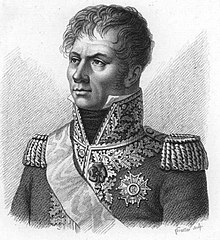Laurent de Gouvion Saint-Cyr: Difference between revisions
| Line 48: | Line 48: | ||
{{MarshalsNapoleon}} |
{{MarshalsNapoleon}} |
||
{{French Revolution navbox}} |
|||
{{DEFAULTSORT:Gouvion Saint-Cyr, Laurent, Marquis de}} |
{{DEFAULTSORT:Gouvion Saint-Cyr, Laurent, Marquis de}} |
||
[[Category:1764 births]] |
[[Category:1764 births]] |
||
Revision as of 03:00, 14 May 2010

Laurent de Gouvion Saint-Cyr, 1st Marquis de Gouvion-Saint-Cyr (13 May 1764 – 17 March 1830) was a French commander in the French Revolutionary and Napoleonic Wars who rose to Marshal of France and Marquis. His nickname was "The Owl".
Early life
Born Laurent Gouvion in Toul, the first born of Jean-Baptiste Gouvion, a tanner, and his wife Anne-Marie Mercier. He adopted the name Saint-Cyr after his mother, who had abandoned him at an early age.
He went to Rome when he was eighteen in order to study painting, but, although he continued his artistic studies after his return to Paris in 1784, he never adopted the profession of a painter.
He married Anne Gouvion (Toul, 2 November 1775 - Paris, 18 June 1844) and had issue, including Laurent François, Marquis de Gouvion Saint-Cyr (30 December 1815 - 30 January 1904), married in Saint-Bouize on 17 August 1847 to Marie Adélaïde Bachasson de Montalivet (5 November 1828 - 14 April 1880), daughter of Marthe Camille Bachasson, Count of Montalivet, and had issue.
Revolutionary Wars
In 1792 he was chosen a captain in a volunteer battalion, and served on the staff of General Custine. Promotion rapidly followed, and in the course of two years he became a general of division. In 1796 he commanded the centre division of Jean Victor Marie Moreau's army in the campaign of the Rhine, aiding in the celebrated retreat from Bavaria to the Rhine.
In 1798 he succeeded André Masséna in the command of the army of Italy. In the following year he commanded the left wing of Jean-Baptiste Jourdan's army fighting in Germany; when Jourdan was succeeded by Masséna, he joined the army of Moreau in Italy, where he distinguished himself in face of the great difficulties that followed the defeat of Novi. When Moreau, in 1800, was appointed to the command of the army of the Rhine, Gouvion Saint-Cyr was named his principal lieutenant, and on 9 May gained a victory over General Kray at Biberach. He was not, however, on good terms with his commander and retired to France after the first operations of the campaign.
In 1801 he was sent to Spain to command the army intended for the invasion of Portugal (see War of the Oranges), and was named grand officer of the Legion of Honour. When a treaty of peace was shortly afterwards concluded with Portugal, he succeeded Lucien Bonaparte as ambassador at Madrid.
Napoleonic Wars
In 1803 he was appointed to the command of an army corps in Italy, in 1805 he served with distinction under Masséna, and in 1806 was engaged in the campaign in southern Italy. He took part 1807 campaigns in Prussia and Poland, and in 1808, in which year he was made a count, he commanded an army corps in Catalonia; but, not wishing to comply with certain orders he received from Paris, he resigned his command and remained in disgrace till 1811.

He was still a général de division, having been excluded from the first list of marshals owing to his action in refusing to influence the troops in favour of the establishment of the French Empire. On the opening of the Russian campaign, Saint-Cyr received command of an army corps, and on 18 August 1812 won a victory over the Russians at Polotsk, in recognition of which he was made a marshal. He received a severe wound in one of the battles during the general retreat. Saint-Cyr distinguished himself at the battle of Dresden (26-27 August 1813) and in the defence of that place against the Allies after the battle of Leipzig, capitulating only on 11 November, when Napoleon had retreated to the Rhine.
Last years
On the Bourbon Restoration he was created a Peer of France, and in July 1815 was appointed War Minister, but resigned his office in the following November. In June 1817 he was appointed Navy Minister, and in September again resumed the duties of War Minister, which he continued to discharge till November 1819. During this time he initiated many reforms, particularly in respect of measures tending to make the army a national rather than a dynastic force. He made efforts to safeguard the rights of veteran soldiers of the Empire, organized the General Staff, and revised the code of military law and the pension regulations. He was made a marquess in 1817. Laurent de Gouvion-Saint-Cyr died on 17 March 1830 in Hyères, a town in the southeast of France.
Writings
- Journal des opérations de l'armée de Catalogne en 1808 et 1809 (Paris, 1821)
- Mémoires sur les campagnes des armées de Rhin et de Rhin-et-Moselle de 1794 à 1797 (Paris, 1829)
- Mémoires pour servir de l'histoire militaire sous le Directoire, le Consulat et l'Empire (1831)
References
- This article incorporates text from a publication now in the public domain: Chisholm, Hugh, ed. (1911). Encyclopædia Britannica (11th ed.). Cambridge University Press.
{{cite encyclopedia}}: Missing or empty|title=(help) In turn, it cites as reference Léonard Honoré Gay de Vernon's Vie de Gouvion Saint-Cyr (1857) - Chandler, David (editor). Napoleon's Marshals. London: Macmillan Publishing Company, 1987. ISBN 0-297-79124-9
- 1764 births
- 1830 deaths
- People from Meurthe-et-Moselle
- Counts of the First French Empire
- French commanders of the Napoleonic Wars
- Military leaders of the French Revolutionary Wars
- Ministers of Marine and the Colonies
- French Ministers of Defence
- French memoirists
- Marquesses of Gouvion Saint-Cyr
- Marshals of France
- Burials at Père Lachaise Cemetery

